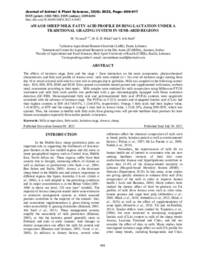Awassi Sheep Milk Fatty Acid Profile during lactation under a traditional grazing system in semi-arid regions

Authors:
The effects of lactation stage, farm and the stage × farm interaction on the main components, physicochemical characteristics and fatty acid profile of Awassi ewes’ milk were studied (n = 16) over all lactation stages starting from day 10 to avoid colostral milk which is very rich in nitrogen due to globulins. Milk was sampled on the following control days: D10, D30, D70, D100 and D130. Ewes grazed on available natural pasture and supplemented with maize, soybean meal, concentrate according to their needs. Milk samples were analyzed for milk composition using Milkoscan FT120 instrument and milk fatty acids profile was performed with a gas chromatography equipped with flame ionization detection (GC-FID). Monounsaturated fatty acid and polyunsaturated fatty acid (PUFA) contents were negatively correlated with the advance of lactation stage. The PUFAs as C18:2t isomers and conjugated linoleic acid (CLA) had their highest contents at D30 (0.87±0.05%, 1.13±0.05%; respectively). Omega 3 fatty acids had their highest value, 1.41±0.05%, at D70 and the omega 6: omega 3 ratio had its lowest value, 1.52±0.19%, during D30–D70, which was optimal. Thus, the increase in healthy milk fatty acids from grazing ewes will provide healthier dairy products for later human consumption especially from earlier periods in lactation.
